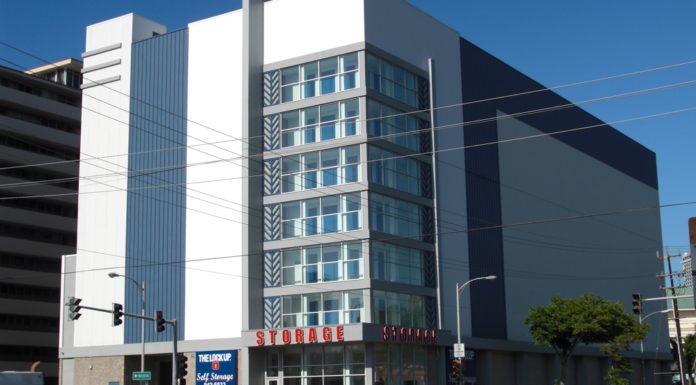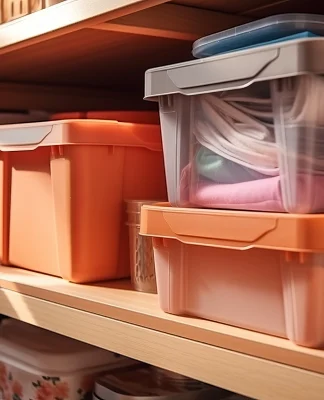Crains Chicago Business, October 1, 2001
Self – storage biz gets crowded as it goes upscale
A visit to the buildings owned by Lock Up Development Corp. in Schaumburg, Lake Forest and a host of other suburbs is a mystery tour of sorts for the uninitiated.
The brick and masonry construction, carpet on the floors and Muzak flowing through the hallways suggest a well-designed office facility. The open spaces in the back, however, have a neat and tidy warehouse look.
Self-storage clearly has moved light years beyond the old tin-sided garage formula common in the 1970s.
In the past few years, as rising competition has permeated the Chicago marketplace, self-storage has gone upscale, with features such as heating and air conditioning, indoor loading docks and state-of-the-art security systems.
“We had an ugly Bates Motel look before, but now we’ve gone to more of a modern Marriott Courtyard image,” says Robert Soudan, president of Northfield-based Lock Up Development, which has 20 self-storage facilities totaling 1.3 million square feet. “At one time, our industry suffered from a reputation for poor aesthetics. Now, we look like hotels and office buildings. We don’t embarrass a community anymore.”
Consumers like the new self-storage facilities, and their willingness to pay the higher rents that come with the amenities has led to rising demand for space. Yet there is plenty of conflict brewing within the industry.
A cascade of new construction in and around Chicago during the past five years — much of it led by deep-pocketed real estate investment trusts (REITs) from out of town — has left the marketplace overbuilt in spots, with landlords worried about flattening rents and creeping vacancies. Many developers, Mr. Soudan included, have curtailed expansion plans, though others are pushing ahead with fresh projects.
‘An interesting business’
Until now, most self-storage development has been dominated by specialists. But the sector has begun to attract the notice of companies new to the business, including Chicago-based Prime Group Inc.
Prime hopes to build a $4-million self-storage facility on seven acres in Barrington, with completion expected by the middle of next year. The company is also planning a facility in Huntley and is seeking sites in Chicago.
“We think it can be an interesting business,” says Jim Magnanenzi, a Prime vice-president.
Interesting, and also profitable. Jim Oakley, an independent self-storage consultant based in Prescott, Ariz., says that developers of self-storage facilities typically enjoy internal rates of return of 30% to 40% on new construction, compared with 25% or less for apartments and shopping centers. Only developers of residential subdivisions, with returns sometimes approaching 50%, do better, Mr. Oakley says.
Yet, he worries that the seemingly easy returns have spawned too many self-storage wannabes with comparatively unsophisticated views of the market.
“A lot of facilities now are being built without feasibility studies,” he says. “Developers don’t look before they leap.”
Falling occupancies
By most estimates, metro Chicago has more than 350 self-storage facilities, up nearly 50% in the past five years. New construction in some communities has come at a dizzying pace. Naperville, for instance, had a single self-storage facility a decade ago, but today has a dozen.
Occupancy rates throughout the Chicago area routinely exceeded 90% a few years ago, but last year in the North Central region, overall occupancies slipped to 84.8%, down from 88.4% in 1999, according to the Self-Storage Almanac published by MiniCo Inc. in Phoenix. Most operators count on 85% or better to bring a good return on their investment.
The occupancy trends are a concern to Larry Nora, president and owner of U-Stor-It LLC in Elgin, which owns nine facilities.
The company plans to open four more this year: a 68,000-square-foot temperature-controlled building in Buffalo Grove, a 55,000-square-foot facility in Arlington Heights and two on Chicago’s Southwest Side. After the current binge, Mr. Nora expects to retreat to the sidelines for a while.
“We’re pulling way back, with nothing else on our development radar screen for now,” he says. “This will be the first time since 1991 that we’ve stopped doing new construction deals. I think we’re at that point in the cycle where supply is starting to outstrip demand. We once saw lease-ups of 95% and better. Now, it’s hard to get to the 90% level.”
Rental rates, he adds, have sagged lately. Through the latter half of the ’90s, U-Stor-It charged tenants — most of whom rent on a month-to-month basis and are free to move around — rent increases of 5% to 10% a year. Most increases this year will be held to about 2%. A typical climate-controlled space in the Chicago area rents for $15 a square foot per year, according to Mr. Nora. Non-climate-controlled facilities get closer to $12.
Seeing opportunities
Bankers who have helped finance the construction boom are beginning to view the industry with a critical eye.
“Pockets in this market are overbuilt, while others still have a fair amount of opportunity,” says Laurence Foy, president and CEO of Merchants & Manufacturers Bank Corp. in Joliet, which has financed a dozen self-storage facilities. “A town like Vernon Hills may well have more self-storage than it needs. But Joliet is probably understored. Will County is growing very fast right now and there will be some opportunities there for self-storage developers.”
Memphis-based Storage USA Inc., the nation’s No. 2 REIT after Glendale, Calif.-based Public Storage Inc., has more than 550 facilities nationwide. It entered Chicago with a deal in Vernon Hills in 1997 and has accumulated nine sites locally. The company will open an 84,000-square-foot facility in Round Lake Beach — a town once considered too remote for self-storage — next spring and is seeking more deals after that.
Richard Stern, Storage USA’s senior vice-president of development, estimates that there is just 1.8 square feet of self-storage capacity in metro Chicago for each resident, well under the national average of 3.9 square feet per capita, according to the Self-Storage Almanac.
“We think the Chicago metro area is still underserved,” Mr. Stern says. “We’re looking to land between 12 and 20 more sites in and around the city over the next couple of years. We’re looking in places like Aurora, South Elgin, St. Charles and Romeoville.”
Other observers believe the statistics are vastly misleading. Most homeowners in places like Arizona and California live in desert areas with no basements and attics. A shortage of storage space at home means self-storage is most popular in those regions. Many companies, sensing a slowdown in new construction, have turned their attention to acquiring existing properties. Lake Bluff-based Metro Storage LLC, Chicago’s second-largest storage company with 30 facilities (behind Public Storage’s more than 100), is constructing a 70,000-square-foot facility in Lake Zurich at a cost of $50 a square foot. That’s considered steep by industry standards, which can be as low as $30 a foot for new construction, land included.
After the Lake Zurich project, Metro has no immediate plans for more construction.
“We think there will be a better risk-reward in acquiring facilities in the future,” says Chairman and CEO Matthew Nagle. His company recently bought a facility in Batavia encompassing 35,000 square feet, and is expanding with a 50,000-square-foot addition.
At the same time, resale prices have been soaring. Marc Boorstein, a principal with the brokerage firm MJ Partners Real Estate Services LLC in Chicago, reports that self-storage facility prices have jumped 30% in the past three years. “The very best locations have skyrocketed in value,” he says.
Self-storage properties typically carried a capitalization rate — price divided by operating income — approaching 11% just two years ago, he adds. Recent deals have been done at less than 10%.
Recycled buildings
In Chicago, meanwhile, self-storage has proven to be a nearly ideal reuse of older manufacturing plants with few other redevelopment options.
Imperial Realty Co. has carved a 150,000-square-foot self-storage space out of the sprawling, 1.3 million-square-foot former W. F. Hall Printing Co. plant on the Northwest Side. With special ventilation and humidity control, it’s become a prime parking lot for antique automobiles in long-term storage.
Imperial is struggling nonetheless. “In 13 years, we’ve raised prices once and lowered prices three times,” says Robert Klairmont, an Imperial vice-president. “At first we didn’t have much competition. But self-storage is popping up everywhere now. This business is a lot tougher than it once was.”


















